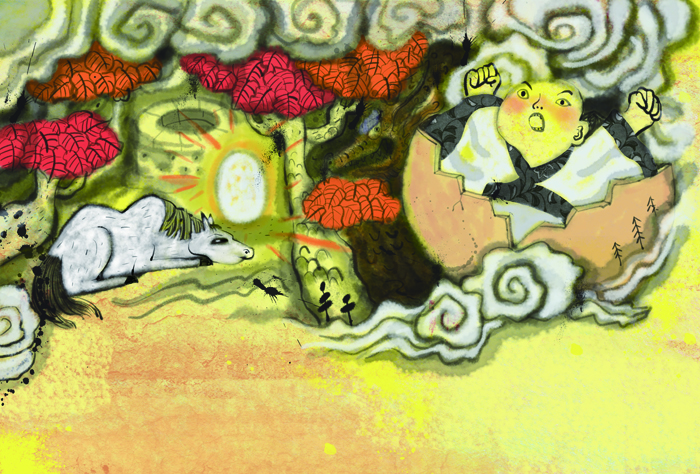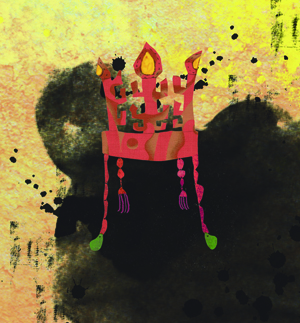View this article in another language
- 한국어
- English
- 日本語
- 中文
- العربية
- Español
- Français
- Deutsch
- Pусский
- Tiếng Việt
- Indonesian
He became king when he was 12 years old. He was a compassionate and wise ruler who founded one of the strongest, wealthiest and most flamboyant kingdoms in the history of the Korean Peninsula. Pak Hyeokgeose (69 BCE–4 CE), known as King Hyeokgeose, founded the Silla Kingdom (57 BCE–935 CE), one of the three kingdoms during the Three Kingdoms era (57 BCE–668 CE) that later unified the peninsula. Besides the unification of the three kingdoms, the Silla era is well-known for its artistic achievement and cultural freedom as well as for the flourishing of Buddhism and broad international ties. This is why when Koreans think of Silla, sumptuous gold accessories, explicitly portrayed clay dolls, precious Buddhist temples, pagodas and artwork are the first things that pop into their heads. The year 2013 marks the 2,070th anniversary of Silla’s foundation, so KOREA takes a look at the life and achievements of King Hyeokgeose and at the kingdom he founded.

Born in a large egg
Before Silla was established, people in Gyeongju, which later became the Silla capital, had no king. They lived scattered across six villages, each with its own chief. One day, they concluded in a meeting that with no king or kingdom, running the villages would be hard. As they sought a virtuous man to serve as king, they saw a light near a well. A white horse was bowing there. When the village chiefs ran toward it, the horse ascended to the skies and a large egg appeared where the horse had been bowing. The egg broke when they touched it, and a young boy was hatched. The village chiefs considered this a sign and named the boy Pak Hyeokgeose; bak after egg and hyeokgeose meaning, “someone who will rule the world with bright light.” They raised him to be king.
An Upright man
According to the Samguksagi, written in 1145, King Hyeokgeose ruled for 60 years from 57 BCE to 4 CE. Go Ungi, a professor of Korean studies at Yonsei University in Seoul, says few historical documents about King Hyeokgeose’s reign remain but a few notable passages in the Samguksagi mention his work and show his character. In the 30th year of his reign, he defeated troops from nearby Nangnang. An anecdote says that after observing that the Nangnang forces did not lock their doors at night, he told his men, “Those people don’t steal from each other, which means the country is a country of morality.” This shows that he was a big enough man to respect even his enemy. Also during his reign, the king of the nearby region of Mahan died, and one of King Hyeokgeose’s officials suggested the invasion of Mahan. But according to one passage, King Hyeokgeose said, “To take other’s misfortunes as our fortune is not a wise move,” indicating his upright nature. The Silla founder died at age 72 and his funeral was held around the present-day stream of Namcheon in Gyeongju.

Silla remembered
Some two millennia later, the culture of Pak’s kingdom is now captivating a global audience. New York will be offered a glimpse into the kingdom of Silla this fall in an exhibition hosted by the Metropolitan Museum of Art. Titled “Silla: Korea’s Golden Kingdom,” the event will feature some 100 Silla relics from Nov. 4 to Feb. 23. The Met will be the first Western museum to have an exhibition exclusively of Silla works. Thomas P. Campbell, director and CEO of the Met, said the show is expected to be one of the most significant displays of Korean art at the Met in more than 40 years. He added that it will transform the public perception of Korean culture and also place the works of Silla on par with the world’s greatest artistic achievements.
Written by Kim Hyung-eun
Illustrated by Shim Soo-keun
*The series of old Korean tales has been made possible with the cooperation with Korea Magazine.

Born in a large egg
Before Silla was established, people in Gyeongju, which later became the Silla capital, had no king. They lived scattered across six villages, each with its own chief. One day, they concluded in a meeting that with no king or kingdom, running the villages would be hard. As they sought a virtuous man to serve as king, they saw a light near a well. A white horse was bowing there. When the village chiefs ran toward it, the horse ascended to the skies and a large egg appeared where the horse had been bowing. The egg broke when they touched it, and a young boy was hatched. The village chiefs considered this a sign and named the boy Pak Hyeokgeose; bak after egg and hyeokgeose meaning, “someone who will rule the world with bright light.” They raised him to be king.
An Upright man
According to the Samguksagi, written in 1145, King Hyeokgeose ruled for 60 years from 57 BCE to 4 CE. Go Ungi, a professor of Korean studies at Yonsei University in Seoul, says few historical documents about King Hyeokgeose’s reign remain but a few notable passages in the Samguksagi mention his work and show his character. In the 30th year of his reign, he defeated troops from nearby Nangnang. An anecdote says that after observing that the Nangnang forces did not lock their doors at night, he told his men, “Those people don’t steal from each other, which means the country is a country of morality.” This shows that he was a big enough man to respect even his enemy. Also during his reign, the king of the nearby region of Mahan died, and one of King Hyeokgeose’s officials suggested the invasion of Mahan. But according to one passage, King Hyeokgeose said, “To take other’s misfortunes as our fortune is not a wise move,” indicating his upright nature. The Silla founder died at age 72 and his funeral was held around the present-day stream of Namcheon in Gyeongju.

Silla remembered
Some two millennia later, the culture of Pak’s kingdom is now captivating a global audience. New York will be offered a glimpse into the kingdom of Silla this fall in an exhibition hosted by the Metropolitan Museum of Art. Titled “Silla: Korea’s Golden Kingdom,” the event will feature some 100 Silla relics from Nov. 4 to Feb. 23. The Met will be the first Western museum to have an exhibition exclusively of Silla works. Thomas P. Campbell, director and CEO of the Met, said the show is expected to be one of the most significant displays of Korean art at the Met in more than 40 years. He added that it will transform the public perception of Korean culture and also place the works of Silla on par with the world’s greatest artistic achievements.
Written by Kim Hyung-eun
Illustrated by Shim Soo-keun
*The series of old Korean tales has been made possible with the cooperation with Korea Magazine.
Most popular
- Military discharge sets stage for reunion of all 7 BTS members
- 'We are back!' BTS Festa heralds hyped return of K-pop phenom
- Presidents Lee, Trump discuss tariff deal in first phone talks
- President Lee leaves for G7 Summit in Canada on first int'l trip
- 'Maybe Happy Ending' wins 6 Tonys including Best Musical
